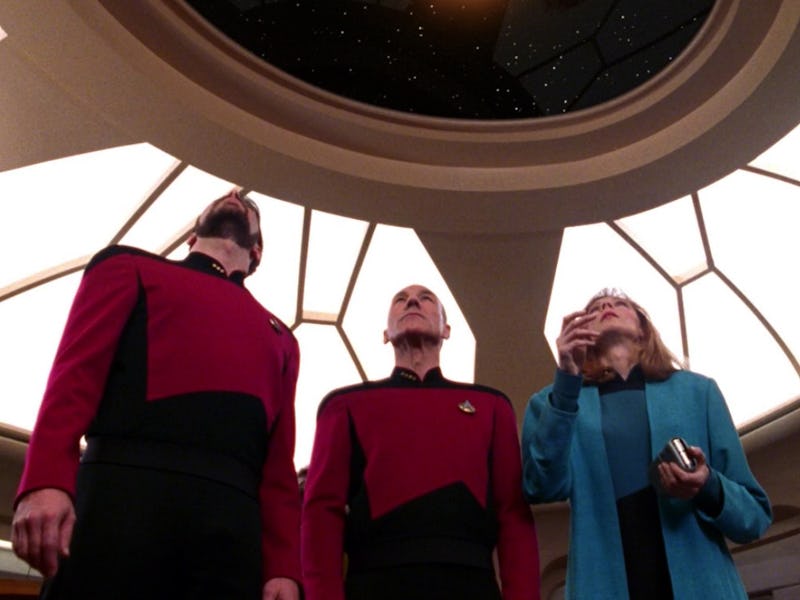One Underrated Star Trek Episode Left Many Unanswered Questions
Whatever became of John Doe?

Star Trek loves it when people turn into aliens. This trope is so common that it literally describes the climax of the first Trek film, as well as, arguably, the entire ending of Deep Space Nine. Depending on which alien species were being talked about, this can either be a good or bad thing. But one of the more interesting things Trek has ever done with this trope is when one alien became a different kind of alien in the underrated Next Generation episode “Transfigurations.”
Because it aired in syndication during the week of June 4, 1990, the episode “Transfigurations” would later live in the shadow of the episode that aired the following week, “The Best of Both Worlds Part 1.” In fact, because of when it came out, it’s fair to say that “Transfigurations” is the most forgotten episode of the golden era of TNG, simply because it retroactively lived in the shadow of not just one of the most famous episodes of the entire series, but one of the most famous TV episodes of all time. But, 35 years later, “Transfigurations” is, if not a great Trek episode, certainly a decent one. And, looking back on it now, it certainly presents more questions than answers.
The crew investigates a crash in "Transfigurations."
Written by René Echevarria, who would later become a Trek powerhouse, with credits spanning TNG and DS9, “Transfigurations” is a fairly quiet episode that presents a sci-fi medical mystery for Dr. Crusher (Gates McFadden) to solve. How can a mortally wounded alien nicknamed “John Doe” (Mark La Mura) be regenerating so much of his body? And why does he have the ability to instantly heal other people? The answer to this question is stretched out over the entire episode and ends with John Doe ascending to a higher plane of existence. His people, the Zalkonians, think that there’s something bizarre and weird about him, but the truth is, many of this race are simply evolving beyond the need for a physical body. Instead of John Doe’s godlike ascension being seen as a bad thing, his evolution is viewed as natural, and like at the end of The Motion Picture, the crew is pumped about being present at the birth of a strange, new life form.
Technically, this is one of those rare Trek episodes in which the crew actually finds a new life form, though in terms of conflict, the stakes are fairly low. And, while this theme was explored again in TNG — and perhaps primed Dr. Crusher for letting go of her son Wesley (Wil Wheaton) when he became a new kind of alien being in “Journey’s End” — the exact species that John Doe transformed into never appeared again.
Godlike aliens that ascend to, or exit on, other planes of existence are, again, somewhat common in Trek. But what’s weird about the Zalkonians is that their ability to help species like humanity seems fairly boundless. Essentially, the crew encounters John Doe, Crusher is very helpful to him, Picard protects him from the space cops, and then, once John becomes yellow energy, that’s it. He, or others like him, never visit the Enterprise again, and there are no other references to this extremely powerful species in the rest of the canon.
Could John Doe have stuck around?
When it comes to extremely powerful non-corporeal and/or godlike aliens that cause problems in Trek, there tends to be a somewhat longer list. The types of aliens on this list that are overtly friendly are somewhat short, which is why it’s interesting, but also somewhat understandable, that John never reappears. If he had returned or stuck around, the Enterprise would literally have had close to zero problems ever again.
In a way, “Transfigurations,” intentionally or not, represents a degree of realism in Star Trek that the franchise sometimes doesn’t get enough credit for. In seeking out new life and new civilizations, Starfleet often encounters a paradox: The vast majority of life that they can make contact with, they probably shouldn’t, because those societies aren’t ready for it. On the flipside, when Starfleet meets really advanced aliens, or aliens about to become super advanced, there’s little our heroes have in common with these types of aliens. This is likely how it would be in real life. Either space explorers are too far beyond us for us to even notice their existence, or we are those space explorers, and the life we’re boldly seeking out is perhaps old hat.
In “Transfigurations,” TNG manages to, briefly, put one foot in each type of alien reality. The final frontier may be full of untold wonders, but the reality is, many of those wonders will remain, understandably, a mystery.